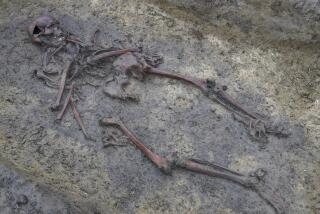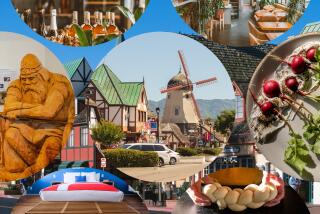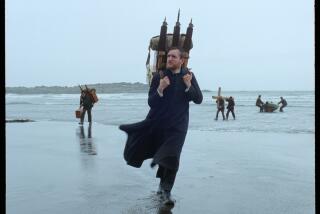Denmark’s Bornholm Island Is Wild and Remote
- Share via
RONNE, Denmark — One of the best things about the island of Bornholm is that few tourists have discovered it.
At the end of World War II, this little island was so cut off from the mainland that the Soviets continued to occupy it for more than a year. It’s between Sweden and Poland in the Baltic Sea, whereas most of Denmark is west of Sweden.
With about 48,000 people scattered over 367 square miles, it still has areas wild and remote.
Bornholm has an almost time-warped sense. Horse-drawn wagons share roads with Peugeots and BMWs. Scythe-wielding farmers work alongside 20th-Century tractors.
The people welcome you with a homey hospitality that’s different from the sophistication found in other parts of Europe.
English Practice
Everyone, it seems, speaks a little English, and most are eager to practice on American tourists. It takes careful listening. Brain translates to brine, and chief means chef.
Scrupulously tidy half-timbered houses that look as if they’ve been painted by numbers cluster around harbors that shelter fleets of colorful fishing boats.
Each year 130 tons of herring are pulled from the stormy Baltic and exported. Even with modern fishing vessels, it’s a tough job when the weather is at its worst, which unfortunately, is a good part of the year.
In August, night temperatures can dip into the 40s. Days, however, are pleasantly sunny and in the 70s, although the island is about on the same latitude as northern Labrador.
Renting a car and circling the island makes a good day-trip.
Begin at Ronne, the capital, and drive north. Stop for the famous soft Danish ice cream at one of the little shops in Hasle. It’s not as sweet as American ice cream, but it’s infinitely richer.
For a look at a runic stone, stroll through the graveyard of the only church in town.
If you feel like hiking, park the car and walk north along the coast through the fishing hamlets of Hellig Peder and Teglkas to Jons Kapel (John’s Chapel). By arriving in the afternoon you’ll be able to watch the fishing boats disgorge the day’s catch.
Near the northern tip is Hammershus, Europe’s largest castle ruin. Built in 1255, it looks like a giant chess piece silhouetted against the sea. It’s a pleasant climb over grassy cliffs to the castle site, obviously chosen for its spectacular--and defensible--view of the coast.
Inside the ruins, diagrams put names to rooms that are crumbled walls.
Golden Cache
Even today the castle may not have revealed all its secrets. In 1967, 22 golden guilders and four gold rings were found. In the 15th Century, one guilder was a whole month’s pay for a mercenary. Was it a soldier’s loot? Or the wages of a thrifty warrior?
Bornholm has four of Denmark’s seven whitewashed round churches, built in the 12th and 13th centuries. Three others are in the south of Sweden. With their conical roofs and squat architectural design, they look like giant cookie jars.
The smallest of these is Ols Kirke. It’s about 3 1/2 miles inland from Allinge, the first town with a paved road leading from it after Hammershus.
Ols Kirke is named for the patron saint Olav, who was also a Norwegian king popular in Denmark. He died in 1031.
The church is typical of all these round structures, with thick granite walls that enabled it to also serve as a combination fortress and storage building.
Its two doors still have holes that were used for barrier booms to keep out intruders. The churches have been restored with uncovered late-Gothic chalk paintings that have an unusual primitive appeal. Members still gather for weekly worship in these holy places.
Back on the coastal route is the village of Gudhjem (God’s Home), which has fewer than 1,000 residents. It’s considered Bornholm’s Capri, as it has become a mecca for artists.
It also has an Italian air, with houses clinging to steep rocks and fig and mulberry trees growing on the hillsides.
Artist’s Studio
Head southwest to the village of Osterlars to see the magnificent forests and picturesque farmland. Also, you’ll come to the pottery studio of Ulla Dybeck.
In a tiny shed overrun with cats and kittens, Dybeck makes bells, pitchers, dishes and bowls in styles that have endured for centuries.
Origins of her work can be identified by the color of the clay--red from Jutland and blue from Zealand.
Go back toward the east coast. Smells from the commercial fish smoker let you know you’re less than a mile from the village of Svaneke.
Blue-white billows pour from five stacks on top of a dark wood building. Inside, herring is being smoked to a golden brown over embers of aromatic alderwood as workers open giant oven doors to refuel or rearrange the shiny fish.
At lunchtime, people pull up to wooden picnic tables for a fresh-from-the-smoker taste of real Baltic herring, traditionally accompanied by a dish of coarse salt. However, you have to be born here to love it.
Fantasy Coastline
More than 100 miles of coastline also add to Bornholm’s fantasylike nature. Balka Beach, south of the town of Nekso, offers about 20 miles of white sand and provides a jumping-off point for windsurfing.
It’s little used except during summer, and perfect for a contemplative, solitary stroll or for playing out a Robinson Crusoe fantasy.
In Ronne, several museums trace the island’s history and geology. Bornholm Museum, open daily except Sunday during summer, has a large selection of grandfather clocks made by hand in small workshops during the 18th and 19th centuries.
At the Bornholm Art Museum, a collection of pottery, paintings and artware shows how crafts have been passed down through the generations.
The Defense Museum traces Bornholm’s stormy military history, including its near-devastation in the 17th Century during wars between Sweden and Denmark.
Another good way to see Bornholm is by bicycle, one of the islanders’ chief means of transportation. Sturdy little two-speeds can be rented for about $5 U.S. a day.
They look like leftovers from “Happy Days,” complete with bells and wire baskets, but their fat tires and wide fenders make them comfortable and easy to handle.
Stick to the network of dependable bicycle paths, totaling more than 360 miles, which crisscross the island. They were created about 20 years ago over railroad beds when all trains were removed.
-- -- --
The best weather hits Bornholm June through August, but April, May, September and October also are pleasant. Peak-season travelers should write ahead for reservations.
Small hotels and pensions include: Hotel Skovly, 3700 Ronne, 70 rooms, about $30 U.S. per person; Pension Svalhoj, 3790 Hasle, 12 rooms, about $16; Hotel-Pension Slottet, 3760 Gudhjem, 12 rooms, $17; Hotel Randklovegard, 3751 Ostermarie, 30 rooms, $22. Rates include breakfast.
The island has eight youth hostels and 22 camping places, plus several pensions.
For luxury, the Hotel Griffen in Ronne, sleek and new and right on the water, has an indoor swimming pool and international restaurant. A double is about $100 a night.
During summer months, Scandinavian Airlines flies daily nonstop service from Los Angeles to Copenhagen and six flights daily from Copenhagen to Ronne. Two ferries that carry cars, with cabins that can be reserved, make the overnight trip daily.
For more information on Bornholm, contact the Danish Tourist Board, 655 3rd Ave., 18th Floor, New York 10017; (212) 949-2333.
More to Read
Sign up for The Wild
We’ll help you find the best places to hike, bike and run, as well as the perfect silent spots for meditation and yoga.
You may occasionally receive promotional content from the Los Angeles Times.






